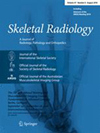Skeletal Radiology the official organ of the International Skeletal Society serves as a forum for the dissemination of current knowledge and information dealing with disorders of the musculoskeletal system including the spine. Although the radiological aspects of the many varied skeletal abnormalities are emphasized the journal also adopts an interdisciplinary approach reflecting the membership of the International Skeletal Society. Thus the anatomical pathological physiological clinical metabolic and epidemiological aspects of the many entities affecting the skeleton each receive appropriate consideration. The format of the journal consists of two principal sections. One section approximately one third of the journal includes a number of short case presentations including histological sections where relevant and a bibliography of the important references. Many of the cases published are selected from the extensive repertoire of material presented at the annual meetings of the International Skeletal Society at which members of the society present a series of interesting and instructive proved cases over a three day weekend meeting. In addition case reports from nonmembers of the Society are published if considered suitable as determined by the Editor of the section. Nonmembers therefore are encouraged to send such cases for editorial consideration. The published cases in this section are selected carefully not only for their esoteric qualities but even more importantly for their inherent value as teaching and hopefully learning exercises.The second section which is approximately two thirds of the journal is more traditional being concerned with the publication of proffered articles. Their selection is made by the editors-in-chief who have the input of a distinguished board of editorial consultants international in scope representing multiple disciplines concerned with disorders of the skeleton. Although emphasis is placed on manuscripts of a radiological interest articles submitted in inter-related disciplines are encouraged. It is also stressed that material dealing with all phases of radiology is welcomed. Thus in addition to conventional diagnostic radiology proffered subject material may cover nuclear radiology computerized axial tomography and magnetic resonance imaging where applicable.
